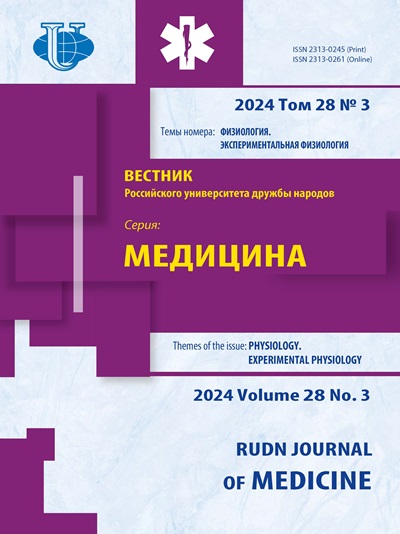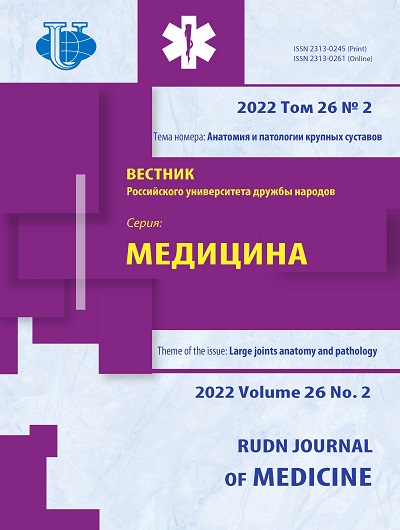Synovial microflora of large joints in patients of a multidisciplinary hospital
- Authors: Schendrigin .N.1, Podsvirova I.A.1
-
Affiliations:
- Stavropol Regional Clinical Hospital
- Issue: Vol 26, No 2 (2022): LARGE JOINTS ANATOMY AND PATHOLOGY
- Pages: 138-149
- Section: LARGE JOINTS ANATOMY AND PATHOLOGY
- URL: https://journals.rudn.ru/medicine/article/view/31075
- DOI: https://doi.org/10.22363/2313-0245-2022-26-2-138-149
Cite item
Full Text
Abstract
Relevance. There is no doubt that microorganisms participate in occurrence and development of septic process in joints. However, the issue of etiological significance of each agent remains controversial, because, in spite of the general trends, indicating the participation of numerous microorganisms in the development of articular pathology, each result of microbiological analysis concerns only a specific case in the territorial and clinical aspects. The aim of the study - microbiological research of synovial fluid obtained from knee joint during synovitis after its aspiration in patients of various departments of the Stavropol Regional Clinical Hospital. Materials and Methods . There were studied 198 samples of synovial fluid. Primary inoculation of puncture was performed with subsequent isolation, identification of the cultures by mass spectrometry and assessment of their antibiotic sensitivity by discodiffusion method. Results and Discussion . 11 cultures of bacterial pathogens were isolated. Gram-positive cocci - 82 %, of which 77.8 % - microorganisms of Staphylococcus genus (44.4 % S.aureus , 33.4 % S.epidermidis ), 22.2 % - other gram-positive cocci: one strain of each, Enterococcus faecium and Streptococcus mitis . Gram-negative pathogens are represented by K.neumoniae and P.aeruginosa with a total content of 18 %. Highly virulent microorganisms S.aureus , K.neumoniae and P.aeruginosa are isolated from the synovial fluid of patients of the surgical departments (orthopedotraumatological No. 1, No. 2) and the rheumatological department. Microorganisms with low virulence E.faecium , S.mitis and S.epidermidis are isolated from synovial fluid of patients of various departments. No obvious resistance of isolated pathogens to antimicrobial drugs has been registered. Conclusion . The presence and species affiliation of the microorganisms identified in synovial fluid allows predicting their etiological significance in development of septic process in joints. Their role as causative agents of nosocomial infections typical for a medical institution is not excluded. The presence of articular pathology in each of the examined departments dictates the need for a clear understanding of the importance of timely and high-quality joint aspiration followed by microbiological examination in almost all patients with damage of large joints, including patients without clinical signs of septic arthritis. Such an approach that makes it possible to identify a greater number of causative agents of septic arthritis and quickly evaluate the dynamics of their antimicrobial resistance should become an obligatory part of a comprehensive research and treatment of a patient with arthritis in multi-fi eld hospitals.
About the authors
Ivan N. Schendrigin
Stavropol Regional Clinical Hospital
Email: rhstav@yandex.ru
ORCID iD: 0000-0002-2386-355X
Stavropol, Russian Federation
Irina A. Podsvirova
Stavropol Regional Clinical Hospital
Author for correspondence.
Email: rhstav@yandex.ru
ORCID iD: 0000-0002-2567-2212
Stavropol, Russian Federation
References
- Teplyakova OV, Rudnov VA, Shly`kova GI, Docenko TG. Septicheskij artrit u vzrosly`x. Klin mikrobiol antimikrob ximioter. 2015;17(3):187—206 (In Russian).
- Cipriano A, Santos FV, Dias R, Carvalho A, Reis E, Pereira C, Santos AC, Sousa R, Abreu MA. Adult Native Joint Septic Arthritis: A NineYear Retrospective Analysis in a Portuguese University Hospital. Acta Med Port. 2021;34(12):826—832. doi: 10.20344/amp.12998.
- Courtney P, Doherty M. Joint aspiration and injection and synovial fluid analysis. Best Pract Res Clin Rheumatol. 2013;27(2):137—169. doi: 10.1016/j.berh.2013.02.005.
- Bayfield NGR, Wang E, Larbalestier R. Medical and conservative surgical management of bacterial sternoclavicular joint septic arthritis: a case series. ANZ J Surg. 2020;90(9):1754—1759. doi: 10.1111/ans.16019.
- Margaretten ME, Kohlwes J, Moore D, Bent S. Does this adult patient have septic arthritis? JAMA. 2007;297(13):1478—88. doi: 10.1001/jama.297.13.1478.
- Duff GP, Lachiewicz PF, Kelley SS. Aspiration of the knee joint before revision arthroplasty. Clin Orthop Relat Res. 1996;331:132—139. doi: 10.1097/00003086-199610000-00018.
- Rasmussen L, Bell J, Kumar A. A Retrospective Review of Native Septic Arthritis in Patients: Can We Diagnose Based on Laboratory Values? Cureus. 2020;12(6): e8577. doi: 10.7759/cureus.8577.
- Massey PA, Clark MD, Walt JS, Feibel BM, RobichauxEdwards LR, Barton RS. Optimal Synovial Fluid Leukocyte Count Cutoff for Diagnosing Native Joint Septic Arthritis After Antibiotics: A Receiver Operating Characteristic Analysis of Accuracy. Journal of the American Academy of Orthopaedic Surgeons. 2021;29(2): e1246-e1253. doi: 10.5435/JAAOS-D-20-01152.
- George J, Chandy VJ, Premnath J, Hariharan TD, Oommen AT, Balaji V, Poonnoose PM. Microbiological profile of septic arthritis in adults: Lessons learnt and treatment strategies. Indian J Med Microbiol. 2019;37(1):29—33. doi: 10.4103/ijmm.IJMM_19_134.
- Pavic K, Pandya J, Sebak S, Shetty A, Spencer D, Manolios N. Acute arthritis: predictive factors and current practice in the approach to diagnosis and management across two hospitals in Sydney. Intern Med J. 2018;48(9):1087—1095. doi: 10.1111/imj.13969.
- Muñoz-E gea M—C, Blanco A, Fernández-Roblas R, Gadea I, García-C añete J, Sandoval E, Esteban J. Clinical and microbiological characteristics of patients with septic arthritis: A hospitalbased study. Journal of Orthopaedics. 2014;11(2):87—90. doi: 10.1016/j.jor.2014.04.002.
- OrnelasAguirre JM. Septic Arthritis in Adults in a Tertiary Care Center. Reumatología Clínica (English Edition). 2016;12. (1):27—33. doi: 10.1016/j.reumae.2015.11.005.
- Vijayvargiya P, Garrigos ZE, Rodino KG, Razonable RR, Abu Saleh OM. Clostridium paraputrificum septic arthritis and osteomyelitis of shoulder: A case report and review of literature. Anaerobe. 2020;62:102105. doi: 10.1016/j.anaerobe.2019.102105.
- Sreckovic S, Kadija M, Ladjevic N, Starcevic B, Stijak L, Milovanovic D. The first case of septic arthritis of the knee caused by Eggerthia catenaformis. Anaerobe. 2022;73:102503. doi: 10.1016/j.anaerobe.2021.102503.
- Costales C, Butler-W u SM. A Real Pain: Diagnostic Quandaries and Septic Arthritis. Journal of Clinical Microbiology. 2017;56(2). doi: 10.1128/jcm.01358-17
- Anikin SG, Alekseeva LI. Vnutrisustavnoe i periartikulyarnoe vvedenie kortikosteroidnyh preparatov: metodicheskie rekomendacii. Moskva: Medpressinform. 2013. 31 p. (In Russian).
- Samojlova NV. Metody lokal’nogo vozdejstviya pri patologii opornodvigatel’nogo apparata: metodicheskie rekomendacii: metodicheskie rekomendacii / Federal’noe gos. byudzhetnoe uchrezhdenie «Rossijskij nauch. centr hirurgii im. akad. B.V. Petrovskogo» Rossijskoj akad. med. nauk. Moskva: Medpress-i nform. 2015. 47 p. (In Russian).
- Reznik LB, Turushev MA, Erofeev SA, Dzyuba GG. Lokal’naya in”ekcionnaya terapiya pri povrezhdeniyah i zabolevaniyah opornodvigatel’noj sistemy. Moskva: Medpressinform. 2016. 128 p. (In Russian).
- Majko OY, Popova LV, Klimova OP, Leont’eva NP. Ul’trazvukovaya diagnostika sinovita u bol’nyh gonartrozom. Vestnik OGU. 2004. 7. URL: https://cyberleninka.ru/article/n/ultrazvukovaya-d iagnostikasinovita-u-bolnyh-g onartrozom. (Accessed 20.11.2021) (In Russian).
- Prikaz Minzdrava Rossii ot 12.11.2012 N 900n “Ob utverzhdenii Poryadka okazaniya medicinskoj pomoshchi vzroslomu naseleniyu po profilyu «revmatologiya» (Accessed 23.08.2020) (In Russian).
- Rui L, Lei S, Qi Q, MingWei L, Wei C, Qiang L, Xiang L, Jun Q, JiYing C. Detecting Periprosthetic Joint Infection by Using Mass Spectrometry. The Journal of Bone and Joint Surgery. 2021;103(20):1917—1926. doi: 10.2106/JBJS.20.01944.
- Lüdemann M, Sulastyanto S, Raab P, Schoen C, Rudert M. Periprosthetic joint infection: Comparison of automated multiplexPCR Unyvero i60 ITI cartridge system with bacterial culture and real-time PCR. Technol Health Care. 2022. doi: 10.3233/ THC-213248. Epub ahead of print.
- TorresSangiao E, Leal Rodriguez C, GarcíaRiestra C. Application and Perspectives of MALDI–TOF Mass Spectrometry in Clinical Microbiology Laboratories. Microorganisms. 2021;9(7):1539. doi: 10.3390/microorganisms9071539.
















